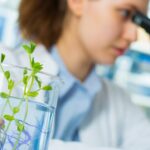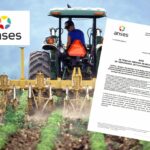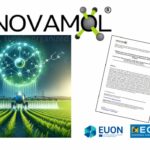
Nanos and agriculture

Nanos and agriculture
By the AVICENN team – Last updated May 2024
The “promise” of nanotechnology in agriculture
Many promises surround nanomaterials in plant protection products. Schematically, we can distinguish several types of benefits that fertilizers and pesticides can bring:
- limit the quantity of active material used, thanks to an active material whose effectiveness is increased by a higher surface-to-volume ratio at the nanometric scale
- trigger self-defense mechanisms of certain plants against diseases (“elicitor” products)
- promote the bioavailability of the active ingredient:
- thanks to its nanometric size, the active ingredient is more easily absorbed by the plants.
- or thanks to a nano-encapsulation which allows a slower release of the active ingredient and more spread out in time (“delay effect”).
- avoid leaching by rain or degradation by light, thanks to the encapsulation of the active ingredient.
Another application of nanotechnologies concerns “precision” agriculture, using nanosensors to optimize growing conditions1A French team is working on these topics: Agrotic. In the US, experimentation with implanting nanosensors inside a plant to detect water stress early is reported in 2018. For more information on the digitization of agriculture, see: The ongoing digitization of agriculture:
identifying key research areas, Science for Environment Policy, 581, June 2022.
Finally, nanotechnology could help in the design of more efficient sensors that can more easily detect pathogenic elements2See for example An overview on the nanotechnological expansion, toxicity assessment and remediating approaches in Agriculture and Food industry, Muthukrishnan L, Environmental Technology & Innovation, 25, February 2022 or traces of plant protection agents in crop products3See for example:
–Nano-sensor detects pesticides on fruit in minutes, Karolinska Institutet, June 2022
–Nanoparticles Make Pesticide Detection Super Sensitive, Asian Scientist Magazine, 5 March 2018.
What nano applications are already on the market?
In the agricultural sector as in all others, we are still in the dark when it comes to identifying products with nano-additives already on the market: plant protection products are not subject to any [nano] labeling obligation4The Biocides Regulation, which makes labeling mandatory [nano], does not apply to plant protection products, and safety data sheets almost never mention the presence of nanomaterials in products.
What do the statements in R-nano tell us
Thanks to the mandatory reporting introduced in France in 2013, it is known that a part of the 500 000 tons of nano substances declared each year in the R-Nano register is used in agriculture, with no further indication of the exact volume or properties of these nanomaterials actually used in that sector.
Since 2014, agriculture is certainly the most important sector of reported usage but this “first place” does not necessarily reflect a high tonnage – it may simply be the result, within the agricultural sector, of the good transmission of information and a higher number of intermediaries between manufacturers and professional users (in this case, farmers)5The distributors of the agricultural sector are well versed in the transmission of information, in particular with the management of pollution charges, via the national database on sales PhytoData..
In the 2016 report, about forty substances in the nanoparticulate state are listed: alumina, silica, calcium, sulfur, titanium dioxide, copper, pigments and various clays (kaolin, attapulgite, Fuller’s earth, …). Rather than active substances, these are essentially fillers/coformulants. ANSES has been conducting audits on this issue since 2017 but has not communicated on their results yet.
Two main families of nanopesticides
While it is difficult to estimate the precise scope of nanos applications in crop protection, an analysis of patents and scientific literature shows that there is a significant number of products that are or will probably be commercialized. In a paper published in Nature Nanotechnology6Wang, D., Saleh, N.B., Byro, A. et al. Nano-enabled pesticides for sustainable agriculture and global food security, Nat. Nanotechnol.17, 347-360, 2022, researchers identified two main families of nanopesticides, based on an analysis of 1163 patents and 500 scientific articles:
- Nanomaterials used as active ingredients and mainly metallic: the most widely used being the nanosilver (as nanobactericides, nanofungicides and nanoinsecticides) and nanoparticles of titanium dioxide (as nanobactericides and nanofungicides)7Two products already marketed in the United States are mentioned: Nu-Clo silvercide (EPA registration number 7124-101, approved in 2007) and DuPont Kocide 3000 (EPA registration number 352-662, approved in 2007).
- Nanomaterials which are used for the nano-encapsulation of the active ingredient: the most common are polymers such as chitosan, cellulose and polyethylene in the form of nanocapsules, nanospheres, nano(hydro)gels and nanomicelles, clay nanoparticles (e.g. silica, montmorillonite and kaolinite), nanocomposites or carbon nanotubes8Cf Figure 1 of the article quoted above.
Lack of transparency from manufacturers
Few distributors were aware of the presence of these nanomaterials in plant protection products before 2013: it is only with the introduction of mandatory reporting that they gradually discovered their existence. If manufacturers were more transparent, things would be less complicated. They do not want to communicate and even refuse to respond to requests for information on their nanomaterials made by the European Chemicals Agency (ECHA).
In 2014, AVICENN was nevertheless able to identify about forty products sold in the agricultural sector that had been declared in the R-nano register by half a dozen companies, without more information being available. Companies do not provide any information on the nanomaterials they use: neither in the safety data sheets of the products concerned (although they were updated after the implementation of R-nano), nor on their website nor on the site of the Union des Industries de la Protection des Plantes (UIPP) (info-pesticides.org).
Little information is given on the delay effect, a property useful for crops. The Union of Chemical Industries (UIC , now France Chimie) and the Medef organization, supported by the Federation of Agricultural Trade (FNA), Coop de France and UIPP have even been asking since 2015 to exempt distributors from filling out the mandatory declaration, which would only increase the already excessive information deficit.
Transparency, the basis for vigilance in the face of risk
By contrast, AVICENN has made proposals that would help strengthen collective vigilance efforts9For example, requiring manufacturers to update the registry e-phy (catalog of fertilizers and pesticides authorized in agriculture available online), specifying with the marketing authorization number (MA) when the product contains nanomaterials and is therefore concerned by the R-nano declaration; then the distributors would inform the national database on sales Phytodata with the postal codes of the end-buyer farmers, then the information on uses would be more complete than in the R-nano register and without additional registration. (The postal codes are certainly relatively imprecise for geolocating uses, but they are sufficient to prioritize and, if necessary, reduce surveillance where there is no issue or increase it by targeting “risky” practices on territories or population groups to be prevented). More broadly, see our suggestions for improvements to the R-nano device.. Indeed, the risks associated with nanos in agriculture are not to be taken lightly, both from the point of view of the environment and the health of farmers and local residents. Transparency is therefore essential in order to exercise the required vigilance.
What about the risks?
As summarized by Indian researchers in a review of the scientific literature published in 2022, “nanotechnologies often involve the use of metal or metal oxide nanoparticles, which can enter the human body and accumulate there through biomagnification. Although their effects on human health are not known, nanoparticles can reach toxic concentrations in soil and leach into rivers and other water bodies, making their disposal a huge economic burden.”10Cf. A comprehensive overview of nanotechnology in sustainable agriculture Arora S et al, Journal of Biotechnology, 355: 21-41, August 2022.
A detailed fact sheet on the risks associated with the use of nanos in agriculture is available by clicking on the link below:
A precise benefit/risk analysis is therefore necessary.
Any questions or comments? This information sheet compiled by AVICENN is intended to be completed and updated. Please feel free to contribute.
Our latest news related to nanos in agriculture
Our information sheets to go further
Upcoming Nano Agenda

- Webconference for analysis laboratories, plant fertilizer manufacturers and distributors, public authorities…
- Moderated by David Krupka, nanotechnologies development manager at AFNOR Normalisation and Emilie Langlois-Bertrand, nantechnologies standardization project manager.
- In partnership with Armand Masion, CNRS Research Director, and Sandrine Mocoeur, Health, Safety, Environment and Quality Manager at SYNGENTA.
- This exchange will also be an opportunity to explore the creation of a national platform to identify standardization needs.
- Website: www.afnor.org/evenement/nanotechnologies-agriculture-cadre-pratique-responsable/
- 8th Congress of Occupational Medicine and Health (CNMST 2026)
- Theme 5: Emerging pathologies and risks, Mr Henri Bastos (ANSES), Pr Lynda Bensefa-Colas (AP-HP), Dr Catherine Nisse (CHU Lille)
- Website: www.medecine-sante-travail.com
- 20th meeting of the “nano and health” dialogue committee
- Organizer: ANSES
This information sheet was originally posted online in July 2017.
Notes and references
- 1A French team is working on these topics: Agrotic. In the US, experimentation with implanting nanosensors inside a plant to detect water stress early is reported in 2018. For more information on the digitization of agriculture, see: The ongoing digitization of agriculture:
identifying key research areas, Science for Environment Policy, 581, June 2022 - 2See for example An overview on the nanotechnological expansion, toxicity assessment and remediating approaches in Agriculture and Food industry, Muthukrishnan L, Environmental Technology & Innovation, 25, February 2022
- 3See for example:
–Nano-sensor detects pesticides on fruit in minutes, Karolinska Institutet, June 2022
–Nanoparticles Make Pesticide Detection Super Sensitive, Asian Scientist Magazine, 5 March 2018 - 4The Biocides Regulation, which makes labeling mandatory [nano], does not apply to plant protection products, and safety data sheets almost never mention the presence of nanomaterials in products
- 5The distributors of the agricultural sector are well versed in the transmission of information, in particular with the management of pollution charges, via the national database on sales PhytoData.
- 6Wang, D., Saleh, N.B., Byro, A. et al. Nano-enabled pesticides for sustainable agriculture and global food security, Nat. Nanotechnol.17, 347-360, 2022
- 7Two products already marketed in the United States are mentioned: Nu-Clo silvercide (EPA registration number 7124-101, approved in 2007) and DuPont Kocide 3000 (EPA registration number 352-662, approved in 2007)
- 8Cf Figure 1 of the article quoted above
- 9For example, requiring manufacturers to update the registry e-phy (catalog of fertilizers and pesticides authorized in agriculture available online), specifying with the marketing authorization number (MA) when the product contains nanomaterials and is therefore concerned by the R-nano declaration; then the distributors would inform the national database on sales Phytodata with the postal codes of the end-buyer farmers, then the information on uses would be more complete than in the R-nano register and without additional registration. (The postal codes are certainly relatively imprecise for geolocating uses, but they are sufficient to prioritize and, if necessary, reduce surveillance where there is no issue or increase it by targeting “risky” practices on territories or population groups to be prevented). More broadly, see our suggestions for improvements to the R-nano device.
- 10Cf. A comprehensive overview of nanotechnology in sustainable agriculture Arora S et al, Journal of Biotechnology, 355: 21-41, August 2022



